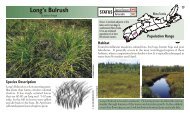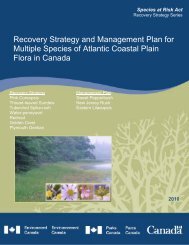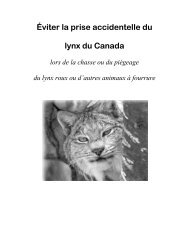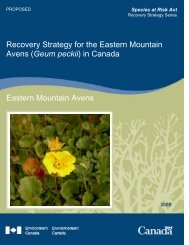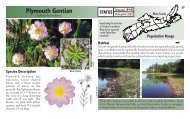Healthy Lakes and Wetlands For Tomorrow - Species at Risk
Healthy Lakes and Wetlands For Tomorrow - Species at Risk
Healthy Lakes and Wetlands For Tomorrow - Species at Risk
Create successful ePaper yourself
Turn your PDF publications into a flip-book with our unique Google optimized e-Paper software.
GLOSSARY<br />
Alien <strong>Species</strong>: Animals <strong>and</strong> plants th<strong>at</strong> have become established in areas outside their n<strong>at</strong>ural<br />
range. Also known as exotic, non-n<strong>at</strong>ive, or introduced species. Not all alien species are invasive<br />
(for example tulips). See invasive alien species.<br />
Atlantic Coastal Plain Flora: The Atlantic coastal plain refers to the rel<strong>at</strong>ively fl<strong>at</strong> l<strong>and</strong> along<br />
the Atlantic Coast from Florida to Nova Scotia. Atlantic Coastal Plain Flora are the group of plant<br />
species th<strong>at</strong> are mainly restricted to this area. There are 90 species of Atlantic Coastal Plain Flora<br />
in Nova Scotia.<br />
Biodiversity: The variety of plant <strong>and</strong> animal life, the genetic variability of each species, <strong>and</strong> the<br />
variety of different ecosystems within a region. An area with many species <strong>and</strong> ecosystems has<br />
more biodiversity than an area with only a few.<br />
Brackish W<strong>at</strong>er: Partially salty w<strong>at</strong>er found in areas where freshw<strong>at</strong>er <strong>and</strong> saltw<strong>at</strong>er mix (such as<br />
mouths of rivers entering the ocean).<br />
critical Habit<strong>at</strong>: Defined in the <strong>Species</strong> <strong>at</strong> <strong>Risk</strong> Act as “the habit<strong>at</strong> th<strong>at</strong> is necessary for the survival<br />
or recovery of a listed wildlife species” (see page 4).<br />
Ecosystem: A community of plants, animals <strong>and</strong> microorganisms, along with their environment,<br />
th<strong>at</strong> function together as a unit. An ecosystem can be as large as a forest or as small as a rotting<br />
log.<br />
Invasive Alien species: Animals <strong>and</strong> plants th<strong>at</strong> have become established in areas outside their<br />
n<strong>at</strong>ural range, th<strong>at</strong> have the potential to harm the environment, economy <strong>and</strong>/or society.<br />
Lake Shoreline: The b<strong>and</strong> of exposed l<strong>and</strong> below the ordinary high w<strong>at</strong>er mark extending to the<br />
w<strong>at</strong>er’s edge (see page 8).<br />
Ordinary High W<strong>at</strong>er Mark: The highest point on the shoreline where w<strong>at</strong>er will rise under normal<br />
we<strong>at</strong>her conditions. It is usually distinguished by the presence of shrubs <strong>and</strong> other veget<strong>at</strong>ion th<strong>at</strong><br />
do not toler<strong>at</strong>e wet conditions (see page 8).<br />
Recovery: The restor<strong>at</strong>ion of a species back to a self-perpetu<strong>at</strong>ing popul<strong>at</strong>ion size.<br />
Riparian Zone: The l<strong>and</strong> next to w<strong>at</strong>er bodies such as lakes, rivers, <strong>and</strong> wetl<strong>and</strong>s (see page 8).<br />
<strong>Species</strong> <strong>at</strong> <strong>Risk</strong>: Plants <strong>and</strong> animals th<strong>at</strong> may not exist in the future <strong>and</strong> need our help. <strong>Species</strong><br />
are assessed by experts <strong>and</strong> are listed under federal <strong>and</strong>/or provincial laws if they are determined<br />
to be <strong>at</strong> risk of becoming extinct. Once a species is determined to be <strong>at</strong> risk, it is placed in one of<br />
six st<strong>at</strong>us c<strong>at</strong>egories depending on how close it is to extinction within Nova Scotia or Canada. The<br />
c<strong>at</strong>egories are Extinct, Extirp<strong>at</strong>ed, Endangered, Thre<strong>at</strong>ened, Special Concern/Vulnerable, <strong>and</strong> Not <strong>at</strong><br />
<strong>Risk</strong> (see page 3 for definitions of each).<br />
Stewardship: Ownership of responsibility for the environment. It means caring for the l<strong>and</strong> in a<br />
responsible way to ensure th<strong>at</strong> healthy ecosystems are passed on to future gener<strong>at</strong>ions.<br />
Wetl<strong>and</strong>: An area th<strong>at</strong> is w<strong>at</strong>erlogged, or partially or completely covered by w<strong>at</strong>er, for all or part of<br />
the year. The Canadian Wetl<strong>and</strong> Classific<strong>at</strong>ion System organizes wetl<strong>and</strong>s into five types (see page<br />
8 for definitions of each).<br />
Did You Know<br />
Some Bl<strong>and</strong>ing’s Turtle h<strong>at</strong>chlings<br />
move very little in a day (10 cm or<br />
less), while others travel hundreds of<br />
meters in one day.<br />
N. Green<br />
62




